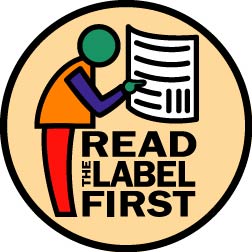
by Julie McConnell | Jul 22, 2013
 When you contact your local extension office for pest control recommendations you will likely hear “follow the label” over and over again. So, why do we emphasize the pesticide label so strongly when talking to both homeowners and landscape professionals?
When you contact your local extension office for pest control recommendations you will likely hear “follow the label” over and over again. So, why do we emphasize the pesticide label so strongly when talking to both homeowners and landscape professionals?
There are many important reasons why you should always read and follow label instructions.
- The Label is the Law – using a pesticide in a manner that is inconsistent with the label is a violation of the Federal Insecticide, Fungicide, and Rodenticide Act (FIFRA). Using a product inconsistent with the label includes, but is not limited to: rate of application, use on site not labeled for control, use on plants/lawns not labeled, frequency of application, method of application, distance from water sources, etc.
- Safety of Humans – using a product incorrectly can cause harm or even lead to death
- Safety to Non-target Organisms – this includes non-target insects, reptiles, birds, fish, mammals, and plants which can lead to negative impact on environment and economy
- Effectiveness of Product – millions of dollars are spent to figure out the most effective way a product works best, follow their instructions! (remember the manufacturer wants the product to be effective so that you’ll recommend to others and buy it again)
- Increased Resistance Decreases Control – improper application and a failure to rotate products as part of an integrated pest management program can increase likelihood of resistant pest populations
Before shopping for any pesticides, do some research:
- Has the pest been identified properly? What life cycle stage is the pest at? Most pesticides have different levels of efficacy depending on life cycle of target. For example, glyphosate works best on young plants that have not yet flowered. Your local extension office can help with identification and timing of control methods
- Can you control the pest with cultural practices such dethatching, irrigation, fertilizer, or mowing height changes? Start with the least toxic method of control and only work up if ineffective
- Read the label before you buy to be sure that it is labeled for your plant /lawn, target pest. The label will also tell you what equipment you’ll need to mix and apply and safety equipment. If product is not ready to use, be sure you can follow mixing and application procedures safely
- Are there particular environmental precautionary statements that are relevant to your site?
- How much do you need? Have you measured the area for treatment? Just as you don’t want to make multiple trips to the store, you also do not want a lot of excess chemicals on hand. They have to be stored or disposed of according to label instructions, too
For more information about pesticide labels read EDIS PI-34 Interpreting Pesticide Label Wording.
by Julie McConnell | Jul 1, 2013

Blueberries
Have you tasted the great local blueberries available this season? Want to start your own Blueberry garden? Now that Blueberry harvest is in full swing in the Florida Panhandle, it is a good time to discuss blueberry culture.
Blueberry plants in garden centers lure us in with bell shaped flowers or especially if already setting fruit. Before you take one home, make sure your site is suitable. Doing your homework before you plant is important, but especially so when you want to grow a plant with specific cultural requirements such as blueberries. Blueberries require well-drained acidic soil that contains organic matter, a minimum of 4-5 hours of sunlight daily, and space away from competing roots. Chill hour requirements and bloom time vary by blueberry types.
Soil in the Florida Panhandle has a wide pH range (measure of acidity) and can vary greatly even within a half-acre site. Having your soil tested prior to planting is critical to growing blueberries successfully because it is very difficult to lower pH if your soil is higher than the target range. Blueberries need acidic soil (pH 4.2-5.5) to be able to use micro-elements in the soil such as iron and zinc. As the pH increases, these nutrients become less available to the plant even if they are present in the soil in adequate quantities. Nutrient deficiency leads to weak plants and loss of vigor. Plan to test your soil before you purchase plants to ensure your site has the ideal pH range, visit your local UF/IFAS County Extension Office to obtain a soil test kit. For more details about how soil pH affects your landscape, please see EDIS SL256: Soil pH and the Home Landscape or Garden.
Sandy soils commonly found in North Florida tend to be low in organic matter. Incorporating soil amendments directly into planting beds or using mulches that decompose (such as pinestraw or wood mulch) will help increase organic matter in your landscape. Peat moss or pine bark can be incorporated into beds planned for blueberries or pine bark can be used as mulch. Adding organic matter will help retain soil moisture, which is beneficial to blueberries that have shallow root systems.
Retaining soil moisture is valuable to blueberries, however, the site does need to drain well to a minimum depth of 18 inches. Areas that remain wet for long periods of time increase the risk of Phytophthora root rot damage. If an otherwise ideal site does not drain well, consider building a raised bed or changing the location.
Four to five hours a day is the minimum sunlight needed for good blueberry production. Make sure your sunny site is at least 20 feet from building foundations and competing tree roots. Blueberry plants can get large, over ten feet in height and width! Plan to give them room to grow; with pruning they can be maintained around 7’x7’.
There are two main types of blueberries that grow well in Florida: the southern highbush and rabbiteye. Among those types, there are specific cultivars with low chill requirements that perform better in Florida than in other southern states. Rabbiteye blueberries are recommended for areas north of Ocala, southern highbush for central and south Florida. When choosing cultivars, you need to plant at least two different cultivars within the same type (rabbiteye with rabbiteye) and make sure that bloom time overlaps so that cross pollination can take place.
Rabbiteye cultivars recommended for the Panhandle are:
Early season
• ‘Beckyblue’
• ‘Bonita’
• ‘Climax’
Mid- to late-season
• ‘Brightwell’
• ‘Powderblue’
• ‘Tifblue’
• ‘Woodard’
• ‘Chaucer’
• ‘Bluegem’
For more information about blueberry site preparation, selection, pest management, and care please see EDIS CIR1192 Blueberry Gardener’s Guide.
by | May 10, 2012

Eddie Powell
Extension Horticultural Courtesy Agent I
Walton County
pep5@ufl.edu
With spring in full swing many Florida homeowners are gearing up to grow their own vegetables. The most frequently asked question this time of year is, “why do I need to fertilize my soil?” The answer is simple – – not all nutrients are present in the right amounts to support good plant health. North Florida is a prime example of an area lacking certain nutrients, since the soils in this area are generally infertile and acidic. Therefore, ample amounts of lime and fertilizer must be applied to the soil for adequate plant growth. If this is not done then the crops will suffer from inadequate plant growth and food supply.
Most vegetable crops grow and perform best at a pH range, 6.0-7.0. A soil sample must be taken to determine soil pH. Feel free to bring one of those samples by your local University of Florida Extension office for your soils pH results. Now if the pH extends far below or above this range, then crop productivity will be significantly reduced. This happens because the crop cannot utilize the fertilizer properly. In other words, this causes the plant to use too much of some nutrients (like manganese, zinc, and iron) that are required in very small amounts and too little of some nutrients (like nitrogen, phosphorus, and potassium) that are required in larger amounts. The plant system becomes upset so to speak and does not function well and some plants may even die.
To avoid having your crop suffer because of a lack of fertilizer, contact your local University of Florida Extension Agent and ask he/she to help you select the best kind of fertilizer for your crop. After you have selected the correct fertilizer, make sure to ask your agent to assist you with following: to figure the correct amount to be applied to the area where you plan to grow your vegetable crops and also how to apply the fertilizer to the soil so that your plants will use it properly for an excellent crop yield.
Things to remember:
To keep your soil pH range between 6.0 -7.0 so that your crop can uptake the fertilizer properly and make sure to apply the correct amounts of fertilizer to the soil so that your plants will not suffer but produce high quality produce.

 When you contact your local extension office for pest control recommendations you will likely hear “follow the label” over and over again. So, why do we emphasize the pesticide label so strongly when talking to both homeowners and landscape professionals?
When you contact your local extension office for pest control recommendations you will likely hear “follow the label” over and over again. So, why do we emphasize the pesticide label so strongly when talking to both homeowners and landscape professionals?

